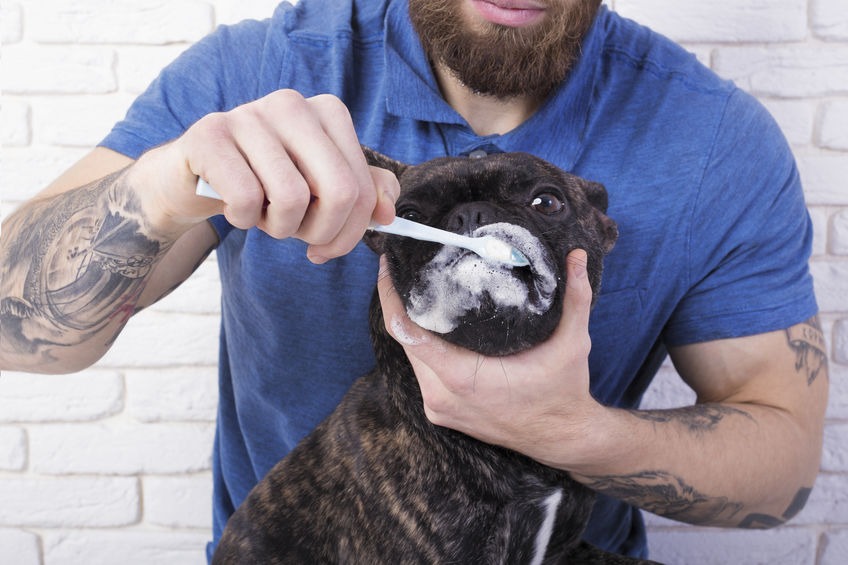You brush your teeth every day to reduce the chances of decay, so why not do so for your dog?
Their diet may contain fewer cavity-forming substances than ours, but they also get dental probs over time. Brushing can help reduce the plaque that contributes to that. It can also stimulate blood flow in the gums. Consistent dental care now can save you and your pooch a lot of cash, hassle and pain down the line.
It might take a little time to be able to brush your dog’s entire set of pearly whites properly. Be patient and the journey might just be a positive one for both of you.
Simple steps to brushing your dog’s teeth (without drama)
- Get a vet-approved dog toothpaste*.
- Give Fido a taste of the flavoured dog toothpaste.
- Finger-brush the front teeth including your canine’s gums with a bit of toothpaste. Do this gently until your doggle is happy with you doing so. You may have to lift the lip carefully (and slowly).
- When pooch is chilled about fingers on his/her front teeth, use a soft toothbrush (let pooch sniff it first) instead of your fingers.
- Give them a healthy treat afterwards to positively reinforce the experience.
- Repeat the process from the start but on the back molars. You may have to raise the lips here, too.
- Be consistent** for best results.
*The ideal toothpaste is a pet-safe enzymatic toothpaste.
**The ideal frequency is daily.
What to expect in the pooch toothbrushing process
Your pooch may be alarmed at the idea (and your odd behaviour) at first. Go slowly and give him/her time to adjust. You want this to be fun; patience is the way to do it.
It may take your hound some time to warm up to the toothpaste. Try dabbing a little on the lip or nose (mind the nostrils, though!) at first, then move on to inserting a small blob into the mouth.
Expect some drooling/salivating (especially if the toothpaste has a yummy flavour) in response to the toothpaste.
Brushing your hound’s gnashers has other benefits
Cleaning your mutt’s teeth lets you keep an eye on his/her dental health. If you see changes like halitosis (unpleasant odour or bad breath), red, inflamed gums, yellowish-brown tartar build-up, bloody gums, odd growths, difficulty chewing, pawing at the mouth, or excessive drooling, your dog might have the early signs of dental disease. If you see these symptoms, it’s time to take a trip to the vet. Besides the bills related to unexpected trips to the vet, the dotsure.co.za Superior plan also covers your doggo’s wellness expenses, such as dental check-ups*. Click/tap here to quote and buy dotsure.co.za pet cover online.
*Limits, exclusions & conditions may apply.
Brushing offers you the chance to bond with your dog.
Handled slowly and maturely (on your part), the time together, the gentle handling, the loving attention from you, and eventual cooperation from your pooch as you earn her trust, is an invaluable experience that will further strengthen your bond with your best friend. Good luck if you have a whole pack of pooches with pearly whites in need of cleaning! You may want to involve the rest of the human family in the process. Turn it into a daily dental ritual for canine and human alike (just wash hands in between each dog and of course before you brush your own teeth!). It’s always wise to directly supervise any children (who might get nipped by accident, or frighten an already-anxious doggle eyeing the toothbrush for the first time).
Are there alternatives?
You can have your dog’s teeth cleaned by a vet.
This “scale and polish” removes the build-up of tartar that simple brushing can’t dislodge. That said, it’s a fairly serious process, requiring sedation (anaesthesia) and potentially the insertion of breathing apparatus during the procedure, so take care with dogs that have unusually shaped trachea like pugs and chihuahuas.
You can try treats that benefit teeth, like gels and snacks.
Let your vet recommend the best ones. “Feeding a high-quality food, avoiding table scraps and using treats that are specially formulated to keep teeth healthy,” Dr. Andy Roark advises on VetStreet.com, “are all easy steps you can take to support dental health.”
Don’t (ever) do this
- Don’t use human toothpaste. It often contains a sweetener called xylitol, which is poisonous to dogs. It also has a foaming agent, and if the dog swallows this, it could cause tummy upsets.
- Don’t brush too hard (or use a hard brush). Doing it gently, and more often, is better. You don’t want to damage gums (which may lead to more serious problems).
- Don’t rely on the toothpaste alone. It’s the brushing that dislodges plaque so it’s important to get in there (gently). It also stimulates the blood flow in the gums.
For more guidance, check out this demonstration from a Vancouver vet.
[embed]https://www.youtube.com/watch?v=54WroRd1GiA&t=1s[/embed]



